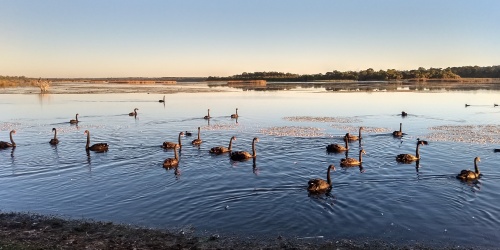
Drummond Nature Reserve. Photo - DBCA
This popular 2012 guide developed by the then Department of Environment and Conservation (DEC) provides information about the nature of Western Australia’s wetlands, and practical guidance on how to manage and restore them for biodiversity conservation. Western Australia’s unique and diverse wetlands are rich in ecological and cultural values and form an integral part of the natural environment of Western Australia.
It is made available now as it remains a good resource for practitioners and community members interested in wetlands management and restoration. It is primarily technical but also addresses policy and legislation which have been superseded. Although it is a good record of policy and procedures at the time it was written, more contemporary documents should be considered to inform current protections and Environmental Impact Assessment processes.
This guide was produced with funding from the Australian Government, the Government of Western Australia, DEC and the Department of Planning and received the support of the Western Australian Wetlands Coordinating Committee.
The guide has been divided into chapters below or can be accessed in full on the DBCA Library website.
Introduction to the guide
Chapter 1: Planning for wetland management
This topic is intended to assist technical officers in local, state government and non-government organisations, landholders, community groups and others working in the field of wetland management and conservation to develop, implement and evaluate the effectiveness of wetland management plans. It aims to provide guidance on wetland management planning in a simple and user-friendly manner (DEC, 2012). It covers:
- wetland management planning
- funding, training and resources
Chapter 2: Understanding wetlands
This topic is intended to assist technical officers in local, state government and non-government organisations, landholders, community groups and others working in the field of wetland management and conservation to develop, implement and evaluate the effectiveness of wetland management plans. It aims to provide guidance on wetland management planning in a simple and user-friendly manner (DEC, 2012). It covers:
- wetland hydrology
- conditions in wetland waters
- wetland ecology
- wetland vegetation and flora
Chapter 3: Managing wetlands
This topic outlines the causes of altered wetland hydrology in Western Australia, the effects of altered hydrology, and potential management responses (DEC, 2012). It covers:
- managing hydrology
- wetland weeds
- water quality
- secondary salinity
- Phytopthora dieback
- managing wetland vegetation
- introduced and nuisance animals
- livestock
Note: Nuisance midges and mosquitoes is listed in the Contents of the guide but was never published.
Chapter 4: Monitoring wetlands
This topic is intended to assist people involved in wetland management and restoration to develop and implement monitoring programs. In particular, the requirements of land managers, landowners, community groups and technical officers in local and state government and non-government organisations have been considered. Consultants, planners and secondary and tertiary students may also find the information useful (DEC, 2012). It covers:
- monitoring wetlands
Chapter 5: Protecting wetlands
This guide was completed in 2012, much of the policy and legislation have changed since this time. Roles and responsibilities have also changed with government merges and restructures. Although it is a good record of policy and procedures more contemporary documents should be considered to inform current protections and Environmental Impact Assessment processes
This topic provides an overview of the roles of these stakeholders in wetland conservation and management including individuals, education and research institutions, businesses, non-government organisations and local, state, and national government (DEC 2012). It covers:
- roles and responsibilities
- legislation and policy




